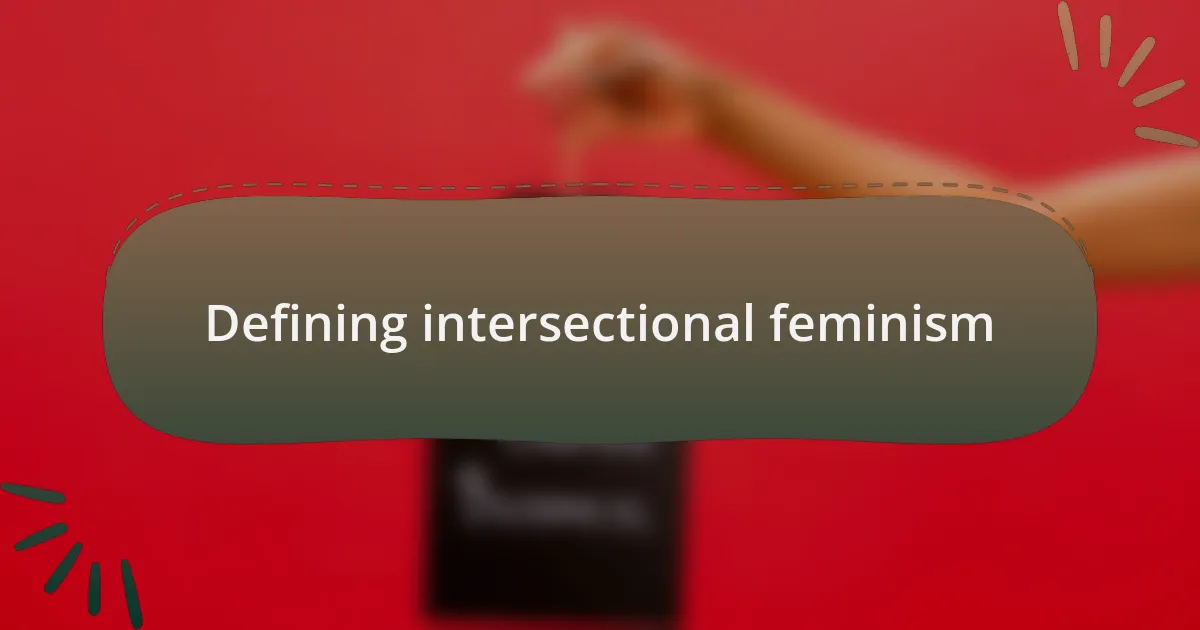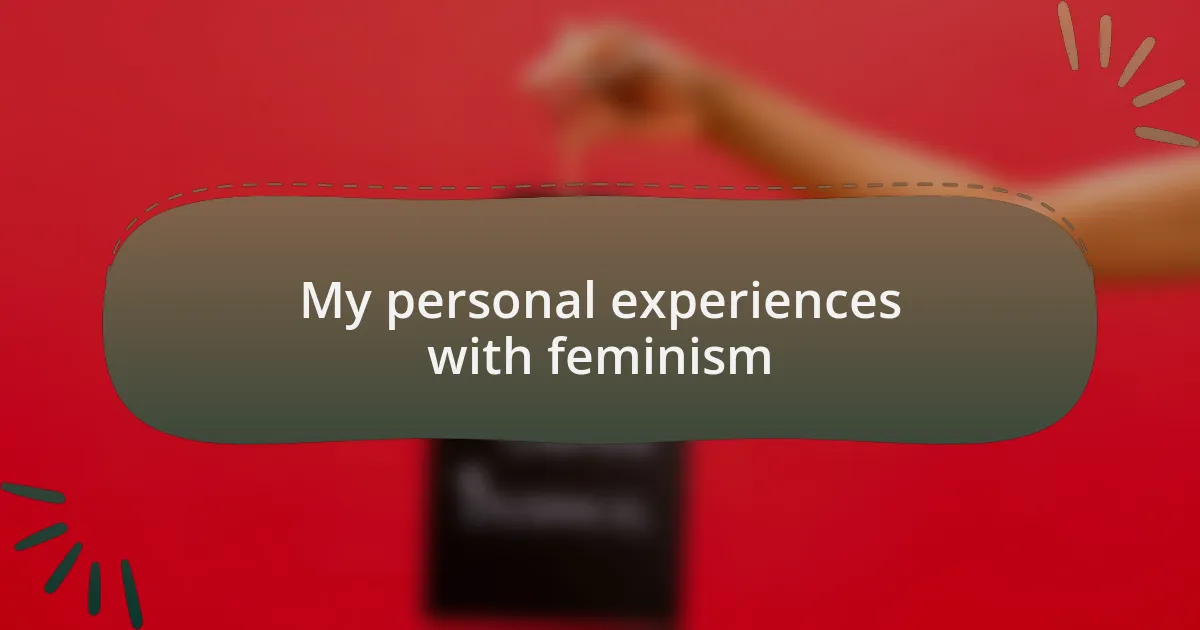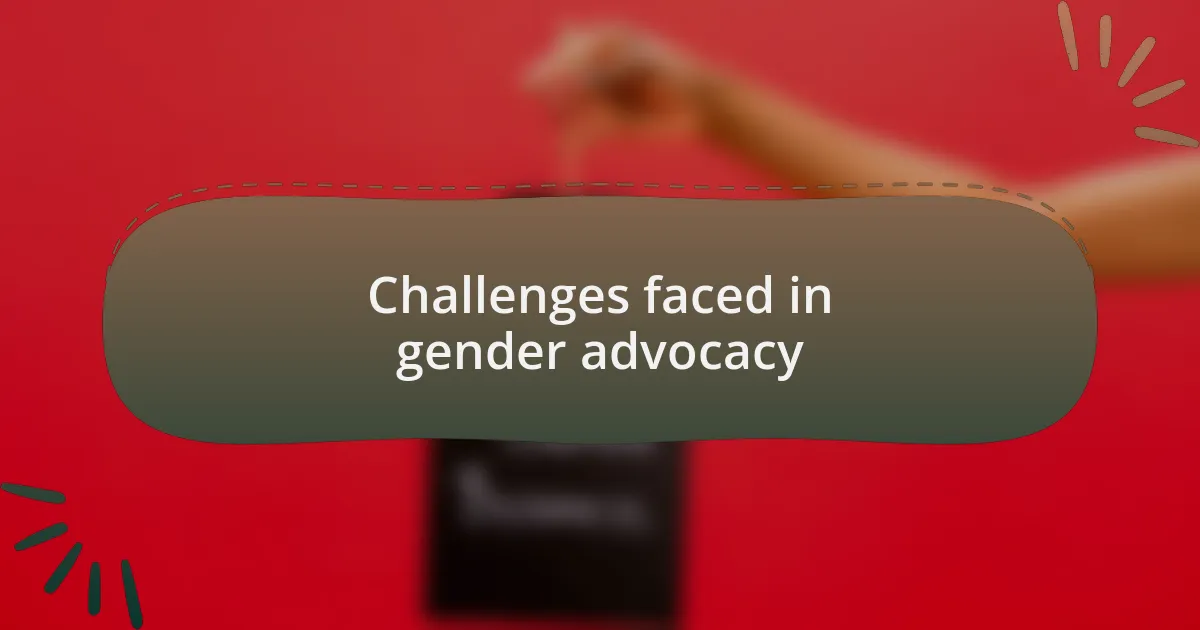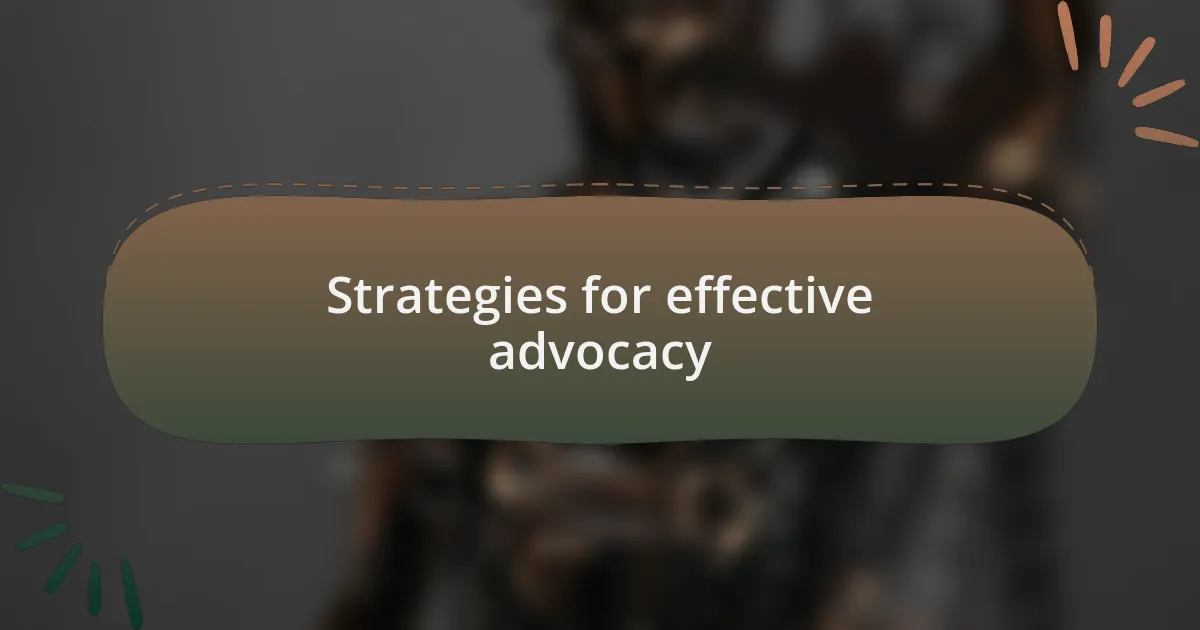Key takeaways:
- Gender equality advocacy requires active engagement from all individuals, not just those directly affected, emphasizing the need for allies to amplify marginalized voices.
- Intersectional feminism highlights the complexities of discrimination, urging advocates to acknowledge diverse experiences and collaborate across movements for holistic solutions.
- Effective advocacy strategies include building alliances, utilizing storytelling to foster empathy, and prioritizing grassroots engagement to amplify marginalized voices.
- Challenges in advocacy include ensuring representation of all voices, combating skepticism, and securing funding for grassroots initiatives.

Understanding gender equality advocacy
Gender equality advocacy goes beyond mere awareness; it’s about active engagement in dismantling systems that perpetuate inequality. I remember attending a local rally where people from various backgrounds united, sharing stories and strategies against gender-based discrimination. It struck me how interconnected our experiences were, yet distinct at the same time—doesn’t that realization challenge us to listen more closely to one another?
Moreover, this advocacy isn’t solely the responsibility of those directly affected by gender inequality; it invites everyone to participate. I often reflect on my own role as an ally—am I providing support in ways that amplify marginalized voices? This question fuels my efforts, shaping how I approach conversations around gender issues in my daily life.
Understanding gender equality advocacy means recognizing that it’s a continuous journey. It requires not just passion, but the willingness to educate ourselves and adjust our perspectives. I find it vital to seek out voices different from my own. It opens up pathways to empathy and underscores the importance of being a part of this critical dialogue.

Defining intersectional feminism
Intersectional feminism is a framework that examines how various forms of inequality, such as race, class, gender, and sexuality, intersect and impact individuals uniquely. For me, understanding this concept was like peeling back layers of my own identity; I saw how my experiences as a woman were deeply influenced by my socioeconomic background. How often do we think about the privileges or struggles we carry based on these intersecting identities?
The term was popularized by Kimberlé Crenshaw in the late 1980s, highlighting that one-size-fits-all approaches to feminism can overlook the diverse realities for women of different backgrounds. When I first read her work, it was eye-opening to realize how many voices were left out of feminist discussions, including my own experiences as someone who often straddles multiple identities. It made me wonder: who else might feel excluded from conversations about justice and equality?
At its core, intersectional feminism encourages us to broaden our perspectives and acknowledge the complexities of discrimination. I think back to a workshop I attended that focused on the specific challenges faced by women of color; the stories were profound and illuminating. It emphasized that true advocacy must reflect this diversity—are we truly listening if we aren’t recognizing the specific needs of all communities involved?

Importance of intersectionality in advocacy
Understanding the importance of intersectionality in advocacy is essential because it highlights the unique challenges that different groups face. For instance, I once volunteered at a local shelter where I saw firsthand how the needs of women varied dramatically based on their racial backgrounds and socio-economic situations. This experience made me realize that our advocacy must be as nuanced as the realities people encounter.
When we incorporate intersectional perspectives, we not only uplift marginalized voices but also enrich our advocacy strategies. I remember working on a campaign that initially aimed to address gender-based violence, but as we engaged more with diverse communities, we discovered that cultural context dramatically shaped individuals’ experiences. This dynamic interaction stressed to me that advocacy must be adaptable and listen actively to the stories that don’t always fit the dominant narrative.
Moreover, intersectionality in advocacy encourages collaboration rather than competition among various movements. I’ve seen how coalitions between feminist groups and racial justice organizations can lead to holistic solutions that benefit wider communities. This makes me reflect: how can we genuinely push for equality if we silo our movements instead of embracing our interconnected realities?

My personal experiences with feminism
Engaging with feminism has reshaped my understanding of empowerment and solidarity. I recall attending a local women’s march, feeling a surge of collective energy as diverse voices merged into one powerful call for justice. It struck me how, while we marched alongside each other, our individual stories were threads woven into a larger tapestry of resilience and struggle. How can one truly advocate for change without acknowledging these unique narratives?
In another instance, I encountered ageism within feminist circles that sparked a deep reflection. During a panel discussion, I observed the dismissive attitudes toward older activists, which left me questioning: Why do we sometimes overlook the wisdom that comes with experience? Recognizing the intersection of age and gender prompted me to seek out and amplify elder voices, understanding that each generation contributes essential knowledge to our ongoing fight for equality.
One particularly impactful moment was when I facilitated a workshop focused on the experiences of women in my community. Listening to their stories of rejection and resilience transformed my approach to feminism. It was a gentle reminder that our struggles are interconnected, prompting me to ask: How do we create an inclusive feminism that lifts all voices? This journey through intersectional feminism has taught me that embracing our differences not only strengthens our movement but also enriches us as individuals.

Challenges faced in gender advocacy
Navigating the landscape of gender advocacy can be rife with obstacles. I once stood before a diverse group of advocates, each passionately voicing their experiences, only to realize that some felt marginalized within our midst. It made me wonder: How do we ensure that no voice is overshadowed, especially those coming from marginalized backgrounds? This realization underscored the importance of creating spaces where everyone feels valued and heard.
Another challenge I faced was confronting the skepticism surrounding our cause. At a community event, I presented statistics about gender-based violence, but I was met with eye rolls and dismissive comments. This experience highlighted a crucial question: How do we communicate the urgency of these issues without overwhelming or alienating our audience? It’s a delicate balance, and I believe that sharing personal stories can bridge that gap, allowing people to connect emotionally rather than just intellectually.
Finally, the issue of funding and resources often looms large in gender advocacy. I recall a funding meeting where the focus shifted away from supporting grassroots initiatives toward larger, more recognized organizations. This left me pondering: How can we uplift local advocates who are tirelessly working to create change? It’s essential for us to prioritize investments in those unsung heroes who often have the most profound impact on their communities.

Strategies for effective advocacy
One effective strategy I’ve found is building alliances with other advocacy groups. Early in my journey, I attended a workshop where organizations from various sectors collaborated on common goals. The power of unity became clear to me when we pooled our resources and shared our platforms, creating a louder, more diverse voice. Have you ever experienced a moment when collaboration opened doors you didn’t even know existed? It’s incredible how working together can amplify our individual strengths.
Another approach involves embracing storytelling as a tool for advocacy. I remember vividly the impact of hearing personal narratives from survivors of gender-based violence during a panel discussion. The raw emotion in their stories shifted the room’s energy and left an indelible mark on everyone present. How can we harness this potent medium to spark empathy and action among those who may remain indifferent? By sharing our own experiences or those of our community members, we invite others to see issues through a more personal lens, which can be transformative.
Lastly, grassroots engagement is vital for meaningful change. I once coordinated a local march that brought together voices from different backgrounds, each carrying a unique story and perspective. The excitement was palpable, as conversations flowed naturally among strangers united by a common purpose. This taught me: how can we cultivate an environment that encourages participation and amplifies marginalized voices? Fostering open dialogue and encouraging community involvement creates a ripple effect, inspiring more people to join the fight for gender equality.